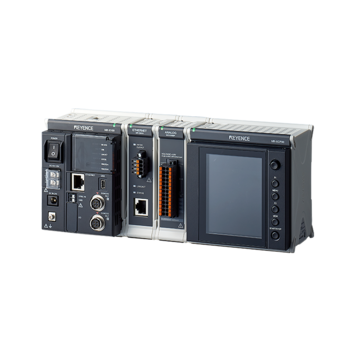Data Acquisition (DAQ)
Guide to FFT Analysis (Fast Fourier & Transform)
-
Tags:
- Data Acquisition
Analyzing and measuring signals from data acquisition (DAQ) devices is important for industrial system monitoring, troubleshooting problems, optimizing system performance, and much more. Learn the basics of FFT analysis and explore the relationship between Fast Fourier Transform analysis (FFT) and data acquisition systems.
What is Fast Fourier Analysis
Fast Fourier Analysis is a computational algorithm that transforms data in the time domain into the frequency domain by deconstructing the components of the data. It's an efficient tool for separating an input signal into its constituent frequencies. In other words, it allows a user to visualize time domain data like a sinusoidal wave into something in the frequency domain that gives a particular frequency on the X-axis and amplitude on the Y-axis. Looking at a waveform and calculating the frequency and amplitude can be daunting.
This algorithm is used in vibration studies, audio analysis, acoustic measurement, and other applications. Fast Fourier Analysis is an optimized version of the Discrete Fourier Transform (DFT). DFT is concerned with discrete time signals and uses summations for computation. In terms of output, DFT produces a discrete spectrum, showing amplitudes and frequencies at specific points.
We’re here to provide you with more details.
Reach out today!

How FFT Works
The FFT process starts with sampling of a number of samples from a signals in a specified amount of time. The signal sampled could be sound, vibration, or any other physical phenomena.
The next step of the FFT analysis is decomposition. This is the phase where the algorithm separates the input signal into smaller parts, looking for patterns that repeat at specific rates. These patterns correspond to different frequencies.
The output of Fast Fourier transform analysis is the frequency spectrum, which provides a visual representation of the input time-based signal.
Common Challenges in FFT Analysis
Certain issues are encountered during FFT. Below are some of the common challenges in FFT analysis.
Spectral Leakage
This happens when energy from one frequency component spreads to adjacent frequency components in the spectrum, leading to energy “leakage”. Leakage can result in reduced frequency resolution, increased noise, incomplete feature extraction, and inaccurate spectral analysis.
Choosing a Window Function
Widowing is designed to minimize or prevent the leakage of a signal’s energy into other parts of the frequency spectrum. However, the technique can also create its own set of issues if the right window function and parameters are not used.
Using the wrong windowing approach can attenuate the signal, leading to a loss of information. It can also cause spectral leakage, which is the issue it seeks to correct.
Issues related to variance could also develop. The window function and parameters can increase the variance of the spectral estimate, making it more difficult to draw accurate conclusions.
Frequency Resolution
Frequency resolution refers to how close two frequency components are and can be distinguished from one another. Limited frequency resolution or closely spaced frequency components can create complications in signal analysis.
Insufficient frequency resolution can happen as a result of an insufficient sampling rate. Also, capability limitations of the data acquisition instrument used for data collection can create issues relating to frequency resolution.
Computational Time
Large datasets and real-time FFT applications require huge algorithmic computational resources. Aside from how large the data points are, the data type, be it single precision or double precision, can affect the memory and operations usage.
When insufficient resources are deployed, the computational process may struggle. Also, the type of FFT algorithm employed can dictate computational time and efficiency. Algorithms such as radix-2 and split-radix have their unique applications and limitations.
Discover more about this product.
Click here to book your demo.

Best Practices for Accurate FFT Analysis
Achieving accurate results during Fast Fourier transform analysis starts with the use of the best data acquisition system. Using the wrong DAQ systems can lead to inconsistent data and inadequate resolution, causing issues during FFT analysis.
Data collected through a data acquisition system—which will serve as an input for the FFT analysis—is as important as the analysis itself. It's crucial to ensure that input data from the DAQ system is collected with sufficient resolution, sampling rate, and duration.
Prepping collected data before FFT analysis is important for accurate results. Removing outliers, trends, and noise is also important and can be achieved through several techniques, including smoothing to reduce noise, baseline correction to remove any baseline drift or offset in the data, and data clipping to cut out data points exceeding a threshold.
While using the wrong window parameters and functions can lead to all sorts of issues, using the right approach will help prevent spectral leakage and help in accurate data analysis.
Factors to consider when choosing an algorithm are the data size, speed requirements, memory constraints, implementation complexity, etc. After choosing the best possible algorithm for the job, keep in mind that calibration may still be required. Fine-tuning and making adjustments where necessary will help minimize errors and improve the accurate representation of physical phenomena being measured.
Importance of Mastering FFT for Effective Data Analysis
Mastering FFT is crucial to effective data analysis in a wide range of applications. Common applications include signal processing in DAQ systems, audio and music, image processing, and vibration analysis.
Accurate Fast Fourier analysis helps engineers and analysts to understand the underlying structure of data, extract hidden information contained, and make informed decisions.
In certain industrial applications, FFT analysis proves to be invaluable. Detecting faults and imbalances in a machine system requires an accurate understanding of FFT. Vibrational data is transformed into the frequency domain to help identify characteristic frequencies of specific components of the machine.
Studying the pattern of the frequencies can alert engineers to where a problem is coming from and can even serve as an early fault detection tool. An accurate understanding of FFT analysis and the use of the right data acquisition systems are important.
As a leader in the industry, KEYENCE offers different multi-input data logger devices for accurate data collection. Our multi-input DAQ solution can measure eight units, including acceleration, vibration, temperature, and pressure, and it supports simultaneous multi-channel measurement of up to 576 channels.
To learn more about the data collection capabilities of KEYENCE DAQ systems, contact us today.
Contact us to learn more about how our advanced technology can help take your business to the next level.
Contact Us



